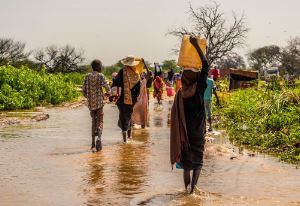Global protection system in flux
A new article provides a fascinating look at what is happening to the global humanitarian protection system as it grapples with rising human displacement and rising numbers of refugees driven by a larger and more protracted range of factors.
Written by Julian Hattem, of the Washington-based Migration Policy Institute, the article says that as the numbers of people forcibly displaced has reached record levels, fewer are finding permanent, durable protection.
It says they are being pushed by “more factors that overlap and intersect in complicated ways”, including an increased number of conflicts and climate change.
Hattem says that the international humanitarian protection system that emerged in the aftermath of WWII has long seemed unable to meet current needs.
“But instead of the collapse of international protection, a series of workarounds and innovations has evolved to offer sanctuary by other forms. Often these protections are of shorter duration,” he writes.
“Some have been implemented in response to fast-moving crises, such as the European Union’s quick triggering of the Temporary Protection Directive when millions of Ukrainians were displaced by Russia’s invasion of Ukraine.
“More than seven decades since its creation, the global protection system finds itself at a crossroads. This moment was long in the works but has been put into overdrive given displacement crises affecting millions of people over relatively short periods—Afghans, Ukrainians, Syrians, and Venezuelans among them,” Hattem writes.
The article also points out that definitions around what constitutes a need for protection are no longer fit for purpose.
The seminal 1951 Refugee Convention limits protection to people with a ‘well-founded fear of being persecuted for reasons of race, religion, nationality, membership of a particular social group, or political opinion’.
“That definition does not include people displaced because they are at risk of starvation, they live in a war zone where bombs are falling haphazardly, or a variety of other reasons that make someplace unliveable,” Hattem writes.
“Also, people are facing newer push factors, most obviously climate change. People fleeing these sorts of situations often find they are not eligible for protection, as do those with mixed motivations that may include economic or family reunification imperatives alongside protection needs.”
 Hattem writes that in the face of rising numbers, some destination countries are closing borders, but others opening gateways inventing ways to stretch the current system to meet contemporary needs.
Hattem writes that in the face of rising numbers, some destination countries are closing borders, but others opening gateways inventing ways to stretch the current system to meet contemporary needs.
“For instance, some countries have gone ahead and labelled people refugees, even if their situation might appear ambiguous. Uganda, for instance, skipped individualized screenings and offered refugee status on a prima facie basis to most of the more than 1.6 million migrants primarily fleeing conflict in South Sudan and the Democratic Republic of the Congo,” he said.
Hattem is ultimately optimistic about the future of the protection system.
“There is little reason to think that displacement will level off or decline, given increasingly complex crises globally and growing inequality. It seems likely that current displacement records will be eclipsed next year and the year after that,” he writes.
But Hattem says the system appears to be pivoting.
“A new generation of policies is taking shape, potentially as flexible as the manifold crises to which they are responding. To be sure, the evolution is imperfect, and the risk is that many vulnerable people will be effectively shut out of international protection,” he writes.
“Still, it took decades for the world to coalesce around an initial set of post-war humanitarian protection standards, so it would be unreasonable to expect a Version 2.0 to develop overnight.
“Whether through new protections or more traditional ones by a different name, many of the major displacement crises of the day have been accompanied by a rush of novel ideas for protecting people in need,” Hattem writes.
Read the full article: Article: Is the Humanitarian Protection System Fal.. | migrationpolicy.org












